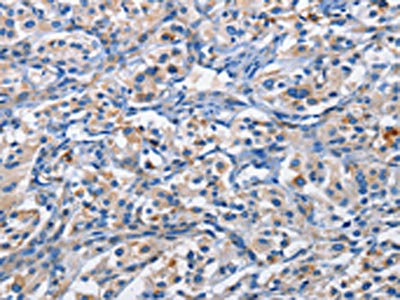
The image on the left is immunohistochemistry of paraffin-embedded Human thyroid cancer tissue using CSB-PA130040(PIM1 Antibody) at dilution 1/50, on the right is treated with fusion protein. (Original magnification: x200)
PIM1 Antibody
CSB-PA130040
ApplicationsELISA, ImmunoHistoChemistry
Product group Antibodies
ReactivityHuman, Mouse, Rat
TargetPIM1
Overview
- SupplierCusabio
- Product NamePIM1 Antibody
- Delivery Days Customer20
- ApplicationsELISA, ImmunoHistoChemistry
- CertificationResearch Use Only
- ClonalityPolyclonal
- ConjugateUnconjugated
- Gene ID5292
- Target namePIM1
- Target descriptionPim-1 proto-oncogene, serine/threonine kinase
- Target synonymsOncogene PIM1; PIM; pim-1 oncogene (proviral integration site 1); proto-oncogene serine/threonine-protein kinase pim-1; serine/threonine-protein kinase pim-1
- HostRabbit
- IsotypeIgG
- Protein IDP11309
- Protein NameSerine/threonine-protein kinase pim-1
- Scientific DescriptionThe protein encoded by this gene belongs to the Ser/Thr protein kinase family, and PIM subfamily. This gene is expressed primarily in B-lymphoid and myeloid cell lines, and is overexpressed in hematopoietic malignancies and in prostate cancer. It plays a role in signal transduction in blood cells, contributing to both cell proliferation and survival, and thus provides a selective advantage in tumorigenesis. Both the human and orthologous mouse genes have been reported to encode two isoforms (with preferential cellular localization) resulting from the use of alternative in-frame translation initiation codons, the upstream non-AUG (CUG) and downstream AUG codons.
- ReactivityHuman, Mouse, Rat
- Storage Instruction-20°C or -80°C
- UNSPSC12352203
